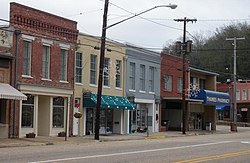Wetumpka, Alabama
| Wetumpka, Alabama | |
|---|---|
| City | |
 |
|
| Nickname(s): City of natural beauty | |
 Location in Elmore County and the state of Alabama |
|
| Coordinates: 32°32′27″N 86°12′28″W / 32.54083°N 86.20778°W | |
| Country | United States |
| State | Alabama |
| County | Elmore |
| Government | |
| • Type | Mayor/Council |
| • Mayor | Jerry Willis |
| Area | |
| • Total | 10.5 sq mi (27.2 km2) |
| • Land | 10.1 sq mi (26.2 km2) |
| • Water | 0.4 sq mi (1.0 km2) |
| Elevation | 185 ft (56 m) |
| Population (2010) | |
| • Total | 6,528 |
| • Density | 645/sq mi (249.2/km2) |
| Time zone | Central (CST) (UTC-6) |
| • Summer (DST) | CDT (UTC-5) |
| ZIP codes | 36092-36093 |
| Area code(s) | 334 |
| FIPS code | 01-81720 |
| GNIS feature ID | 0155305 |
| Website | www |
Wetumpka is a city in and the county seat of Elmore County, Alabama, United States. At the 2010 census the population was 6,528. In the early 21st century, Elmore County, long a rural area, became one of the fastest-growing counties in the state. The city is considered part of the Montgomery Metropolitan Area.
Wetumpka identifies as "The City of Natural Beauty". Among the notable landmarks are the Wetumpka crater and the Jasmine Hill Gardens, with a full-sized replica of the Temple of Hera of Olympia, Greece. Historic downtown Wetumpka was developed on both sides of the Coosa River, and Fort Toulouse was built near it.
The word Wetumpka is derived from the Native American phrase "we-wau" "tum=cau". The Name Wetumpka is a historic Creek place word meaning "rumbling waters", supposedly a description of the sound of the nearby Coosa River as the water falls over the rapids of the Devil's Staircase. It could be heard for miles before the construction of Walter Bouldin Dam, and Jordan Damn. The Creek named Wetumka, Oklahoma, after their historic village after being forced west to Indian Territory (present-day Oklahoma), by United States soldiers under the Indian Removal Act of 1830.
The area around Wetumpka was the heart of the Upper Creek lands, whose largest towns were located on the banks of the Coosa and at its confluence with the Tallapoosa River, at Wetumpka and Talisi (now Tallassee), respectively.
After moving the 1702 settlement of Mobile to Mobile Bay in 1711, Jean-Baptiste Le Moyne, Sieur de Bienville sent an expedition up the Alabama River to establish a fort in the interior of New France, both to stop the encroachment of the British and to foster trade and goodwill with the Creek.
...
Wikipedia
